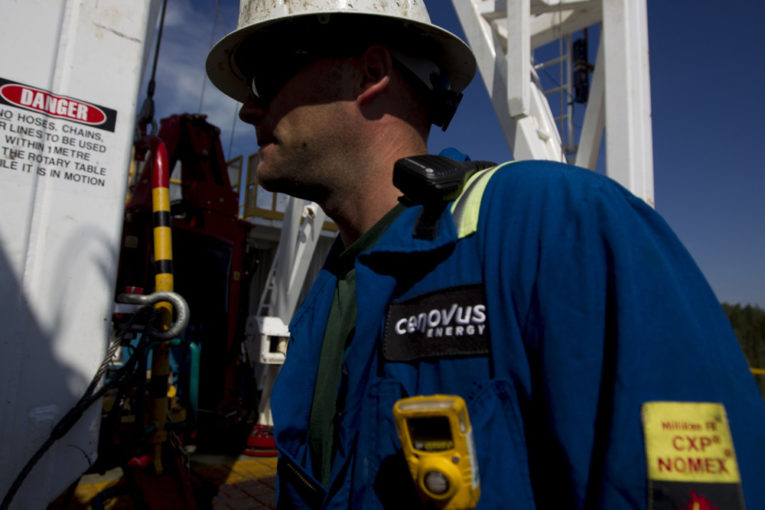
CALGARY – One of Canada’s largest oilsands producer says the industry needs support from Ottawa quickly to survive and emerge as a major contributor to the country’s economic revival in the months to come.
“We have had significant discussions with both the Alberta government and the federal government about the need for incremental liquidity support,” Cenovus Energy Inc. president and CEO Alex Pourbaix said on an earnings call Wednesday.
“We’ve been hearing for weeks that support is coming. Weeks have passed and the industry is still waiting and particularly, the larger side of the industry,” he said.
On March 25, Finance Minister Bill Morneau said help would be available in “hours, potentially days, to ensure there are credit opportunities particularly for the small- and mid-sized firms in that sector.”
On April 17, the federal government announced $1.7 billion to clean up orphan oil wells in Western Canada, $750 million in grants for energy companies to reduce methane emissions and loans ranging in size between $15 million and $60 million through the Business Development Bank of Canada and Export Development Canada to mid-sized oil and gas producers.
The federal government has not signalled whether additional help is coming to larger oil and gas producers, but Alberta Premier Jason Kenney thinks the industry would require $20 billion in loan support.
Pourbaix acknowledged the federal government has made loan supports available to small and mid-sized companies through the BDC and EDC, but larger companies in the industry also need the support.
Pourbaix said Cenovus has credit available to survive the current downturn but other companies aren’t so lucky and the Canadian energy industry, one of the largest contributors to the country’s GDP, will be needed to pull Canada out of a recession.
“The province and the country are amassing significant deficits as a result of this crisis and once the current situation passes, we’re going to need a rapid injection of revenue to support Canada’s economic recovery,” Pourbaix said. Following the 2008 financial crisis, the rebound in the energy industry helped lead the country out of recession, he said.
The current challenge facing energy producers is greater than what followed the 2008 financial crisis. On Wednesday, the Western Canadian Select benchmark price for heavy oil jumped close to 44 per cent in mid-day trading to US$7.25 per barrel, still well below the price domestic producers need to break even.
Cenovus recorded a roughly $1.8-billion net loss for the first quarter on Wednesday and said it’s reducing output by roughly 60,000 barrels of oil per day as a result of the coronavirus pandemic-induced reduction in oil demand. That’s about 14 per cent of the 417,000 bpd of oil the company produced in the first quarter of this year.
Similarly, Husky Energy Inc. reported Wednesday a $1.7-billion net loss for the first quarter, still better than the $2.3-billion net loss it reported a year earlier.
“In response to the unprecedented events this year, we took immediate action to reduce expenditures and safely shut in uneconomic production,” Husky chief executive officer Rob Peabody said during the company’s annual meeting Wednesday.
The company has suspended construction on projects in Saskatchewan, offshore Newfoundland and on its refinery in Superior, Wisc., and cut its capital budget by half to $1.6 billion.
China’s CNOOC Ltd. also cut production at its Long Lake oilsands operations and reviewing staff count, it said in an earnings call Wednesday.
Rystad Energy expects total upstream spending in the Canadian oil and gas industry to fall below $21 billion this year, a 41 per cent decline over last year, to reach a 20-year low. In a report published earlier this week, the Norwegian energy research firm also predicted a total of 1.2 million barrels of daily Canadian oil production would be shut in.
As bad as the first quarter results were, analysts expect additional pain for the Canadian energy sector as much of the carnage from the coronavirus pandemic and oil price war between Saudi Arabia and Russia occurred in April, which plunged some oil contracts into negative territory.
Raymond James analyst Chris Cox warned that weak results Wednesday were a preview of quarters to come.
Cox believes there is some upside potential for Cenovus if oil prices improve, but warned in a research note that, “the magnitude of the balance sheet deterioration is more significant than perceived by consensus, putting the company in a fairly large hole coming out of this downturn.”
Similarly, Husky’s results provide some foresight into how bad the second quarter will be given the fall in demand for gasoline, jet fuel and diesel from its refineries, Eight Capital analyst Phil Skolnick said in a research note.
“This will be a test on how far ahead investors are willing to look, given conversations of late have focused on what the companies will look like in a post COVID-19 world,” Skolnick wrote.
Shares in both Cenovus and Husky rallied Wednesday despite the weak results. In midday trading, Cenovus rose 10 per cent, or 44 cents per share, to $4.82 per share on the Toronto Stock Exchange, while Husky shares rose 9 per cent, or 34 cents, to $4 per share.
U.S. crude oil price benchmark jumped 22 per cent to US$15.06 per barrel Wednesday after U.S. crude inventories grew less than expected, fuelling optimism as some European countries and U.S. states ease coronavirus lockdowns.
Financial Post
• Email: [email protected] | Twitter: geoffreymorgan
You can read more of the news on source
